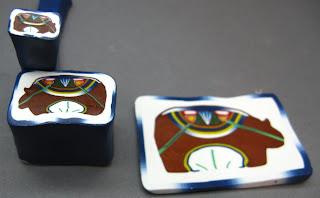Materials:
· Clay in your choice of colours or patterns or textures
· Foil leaf or Jones Tones/Lisa Pavelka foils, enough to cover two large circles, silver works best, but other colours are interesting, too
· Two donut or rondelle crystal beads in your choice of colour
· Four headpins
· Pair of earring findings.
· Wire cutters, Round nose pliers, Small drill.
· Circle cutters, large (1 inch – 1.5 inch) and small size (1/2 inch to ¾ inch)
· Marble (1 inch approx, also known as shooters) and small to medium size lightbulb
· Weldbond or other glue
· Small drill
· Toothpicks and Piñata ink if tinting rondelles
· A few drops of Future floor polish or your choice of gloss finish
Instructions
The bead is composed of four pieces and requires three short bakings and one long baking.
The back piece (this will be the back of the earring)
1. Decorate or texture a medium to thin sheet of clay clay large enough to cut two circles from your larger circle cutters. Cut two large circles.
2. Place the clay circles on the marble (texture or pattern side out) and roll gently in your hands to shape to the marble.
3. Bake on the marble for 10 minutes. Cool.
4. Remove from marble.
The glow piece (make while baking the back piece, this goes inside the back piece)
1. Roll clay out to thin setting, large enough to cut two circles from your large circle cutters.
2. Foil the clay using your choice of foils.
3. Cut two large circles.
4. Smooth one of the foil circles foil-side-up into the inside of the cooked back piece so that it conforms to the back piece and makes a cup shape.
5. Trim even with edge of back piece.
6. Do this with other back and foil piece.
7. Bake for 10 minutes.
8. Cool, and coat the foiled piece with thin layer of Future or your choice of gloss sealer. Dry. I find placing the piece on top of (not inside) a hot oven makes the curing go faster.
The top lip piece (this is the part that you see when staring straight at the earring)
1. Roll clay out to med setting, large enough to cut two large circles.
2. Cut circles out of clay and place cut circles onto lightbulb.
3. Cut smaller circle from inside of larger circle while on lightbulb so that it forms an “O” shape. You can be off centre if you like. Don't try to remove the smaller circle - you'll sometimes accidentally distort the large circle.
4. Reshape larger circle if necessary by placing large circle cutter over and gently using a spirograph motion around clay circle.
5. Texture or finish large circle if desired.
6. Bake on lightbulb for 10 minutes.
You may want to do two pairs – one with a larger inside hole and one with a smaller inside hole. After the 10 minute bake is up, place outside lip piece on top of the back piece with the glow piece inside. Place a donut bead inside and see which lip piece works best and which colour bead you like. This is trial and error.
You can also get creative here and use different shapes for the inside, or decorate the outside with additions.
The inside lip piece (which joins the top piece to the glow piece) and clay bead assembly
1. Roll clay out to thin setting, large enough to cut two large circles.
2. Cut out two large circles. Cut a smaller circle into the large circle so that you have an “O” shape.
3. Place inside lip on underside of cured top lip piece.
4. Place the back piece onto the inside lip, squeeze together.
5. Smooth the inside lip clay on the backside and on the inner circle of the outside lip.
6. Bake for 30 minutes for a final cure.
The donut bead
1. If you’ve got clear rondelles, applying a couple of drops of Pinata or other inks will tint them to a colour of your choice. Let dry. Otherwise you can do what I did and buy a crystal bracelet from the local dollar store.
2. Future Floor Polish can cause a colour shift in the Pinata Ink. This may be something you want. Dip the bead into Future Floor Polish and shake off excess. Apply a couple of drops of Pinata ink. Let dry.
3. Beads aren’t perfect, and some will cause more glow than others. Experiment.
Final Assembly.
1. Drill hole in centre of glow piece.
2. Place a small dollop of Weldbond or other glue on top of hole on the inside of the glow piece.
3. Apply glue to headpin and thread headpin onto donut bead and then through hole. This secures the bead to the earring.
4. Let dry and trim headpin excess flush with back of glow piece.
5. Drill small hole through from the outside lip join to the back piece through to the inside join of the lip to the back piece. This allows for the earring to be attached to the bead.
6. Thread another head pin through this hole and on the outside create a circle with the headpin wire to allow for placement onto earring finding.
Alternatively you can trim the headpin/bead combination to a longer length and use it for a brooch using the clamp fasteners, or you can create a loop on the back side and use it for a bracelet.
Samples from the class are shown below. The pink beads have been dyed with Pinata Inks. In the centre you can see the Jones Tones foils - they're also in the Bottle of Hope flower.
Please let me know if you find any mistakes or need clarification. They're actually easier than the instructions make them appear to be.
Hope you enjoy!
Sandy




















